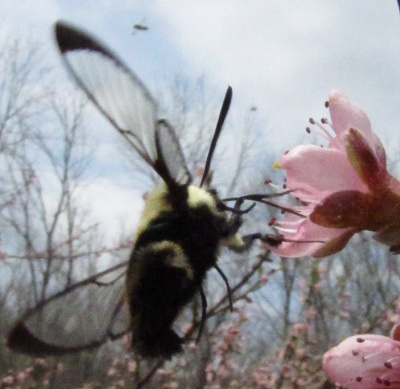
Overwintering sites for native pollinators
 The final habitat requirement
of native pollinators is a spot to spend the winter. Most native
bees winter in their summer nest tunnels or burrows, but bumblebees
need a sheltered spot with plenty of leaf litter in which to
hibernate. Some non-bee pollinators spend the winter in tall
grass, bushes, trees, piles of leaves or sticks, or on man-made objects.
The final habitat requirement
of native pollinators is a spot to spend the winter. Most native
bees winter in their summer nest tunnels or burrows, but bumblebees
need a sheltered spot with plenty of leaf litter in which to
hibernate. Some non-bee pollinators spend the winter in tall
grass, bushes, trees, piles of leaves or sticks, or on man-made objects.
In general, the best way
to protect pollinators in the winter is to leave them alone. If
you need to manage your pollinator meadows by mowing or burning, try to
do so in the late summer or fall while the insects are still active and
can get away. Even if you don't have a designated pollinator
area, it's worth leaving some overgrown, weedy spots along the edges of
your garden to give these important insects a winter home.
Want to know more about
native pollinators? Here are some extra sources:
- Attracting Wild Pollinators --- This beautifully illustrated book was the source for this week's lunchtime series. It delves much further into all of the topics mentioned here.
- Native pollinators --- This lunchtime series covers four of the most common types of pollinators in our garden --- sweat bees, small carpenter bees, miner bees, and the greater bee fly.
- Bumblebees
--- Learn about buzz pollination, bumblebee identification, and more in
this lunchtime series.
| This post is part of our Attracting Native Pollinators lunchtime
series.
Read all of the entries: |
Want more in-depth information? Browse through our books.
Or explore more posts by date or by subject.
About us: Anna Hess and Mark Hamilton spent over a decade living self-sufficiently in the mountains of Virginia before moving north to start over from scratch in the foothills of Ohio. They've experimented with permaculture, no-till gardening, trailersteading, home-based microbusinesses and much more, writing about their adventures in both blogs and books.
Want to be notified when new comments are posted on this page? Click on the RSS button after you add a comment to subscribe to the comment feed, or simply check the box beside "email replies to me" while writing your comment.
